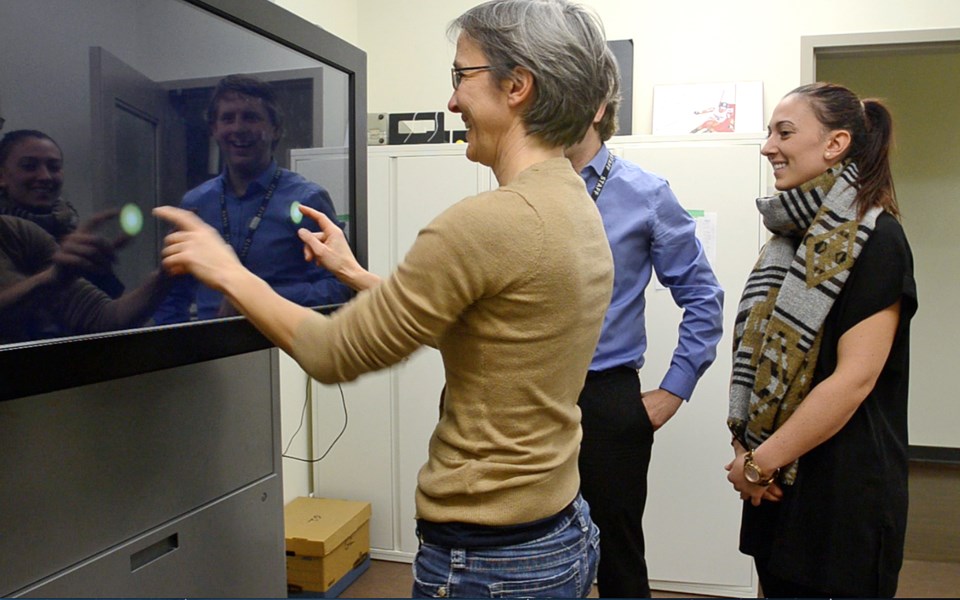For 14 weeks, NOW health reporter Cornelia Naylor has been assigned to undertake a “Fortius challenge,” setting fitness and performance goals and experiencing first-hand the many ways Burnaby’s Fortius Sport & Health can help.
As a rehab project, the team will zero in on a lingering shoulder injury, but Cornelia will also get a chance to sample everything else Fortius has to offer, from massage therapy and diet advice to vision testing and a scientific analysis of her running gait.
Here’s her sixth report:
My dreams of becoming an Olympic shooter are over.
Fortius Sport & Health eye doctor Kevin Loopeker has just told me that I’m left-eyed.
I’m also right-handed, so he said it’s doubtful I’d ever be able to shoot at an elite level since my eye and weapon would be naturally unaligned.
Luckily I hadn’t gotten around to actually taking up the sport.
It’s a good illustration, though, of why there are a group of eye specialists and a whole lot of expensive vision-related equipment at a sports medicine centre.
“A lot of people ask me why do we have vision here,” Loopeker says. “Just try to perform a new sport with your eyes closed.”
There are blind athletes, of course, and better testing at a place like Fortius could help with more accurate classification for competition.
But sighted athletes rely heavily on their vision – even if they sometimes take it for granted.
“It tells you where you are in space,” Loopeker says. “It tells you where the ball is, it tells you where your opponents are, it helps with your balance and it tells you when the ball is going to arrive.”
Vision, especially for athletes, goes well beyond being able to see clearly, for Loopeker.
“There’s more than one skill,” he says.
Besides clarity, there’s eye-hand coordination, peripheral awareness, depth perception, tracking, visual memory and many more.
Which of these skills athletes need, depends on their sport and position, according to Loopeker
A football quarterback, for example, needs great peripheral awareness, he says, while an Olympic shooter needs exceptional clarity and stable focusing in one eye.
So – while Fortius’s performance vision centre has all the equipment for regular eye testing – it goes well beyond making sure athletes’ eyes are healthy and they can see 20/20.
Take the centre’s Nike SPARQ Sensory Performance Station – the only one in Canada.
A 30-minute test on the unit’s touch-screen TV evaluates 10 different visual skills and compares athletes to others around the world playing their sport and position.
It’s one of the ways Fortius’s eye experts uncover weaknesses that could be holding athletes back.
Once those have been pinpointed, some can be corrected with what Loopeker calls “physiotherapy for the eyes.”
All that work happens in the “fun room” or the “kindergarten room for the eyes,” a.k.a. the Fortius vision training room.
“What really sets us apart is this room here,” he says.
Besides the Nike SPARQ, the room contains an array of what look like toys and arcade games.
“It’s just adding the science rather than making it recreational,” Loopeker said.
Some of the “toys” are as simple as baseballs with letters written on them hanging from the ceiling. Those are for strengthening eye-tracking skills.
Somewhat more high tech are the Nike SPARQ Vapor Strobe glasses.
I put on a pair and play a game of catch with Loopeker.
It’s a bit like looking through a venetian blind opening and closing dozens of times a minute.
By limiting visual input, Loopeker explains, the specs force the wearer to be more attentive, to anticipate and predict.
It’s a tool he uses with a handful of junior hockey goalies training at Fortius.
When I take the glasses off, the ball seems bigger and slower and easier to manage.
Trippy.
Loopeker likens it to pulling off the highway after driving 120 km/h for a couple hours – 50 km/h seems almost too slow.
More than half of Loopeker’s clients at Fortius see him to get help with the light sensitivity, headaches and peripheral motion sensitivity that come with concussions.
It’s important work, but Fortius’s vision experts would like to see more athletes – especially developing athletes – take advantage of the centre’s expertise and tools to boost their performance.
The challenge is getting the word out.
“Awareness is the biggest thing,” Loopeker says.
Next stop, base-line concussion testing.
Follow Cornelia Naylor on Twitter, @CorNaylor



